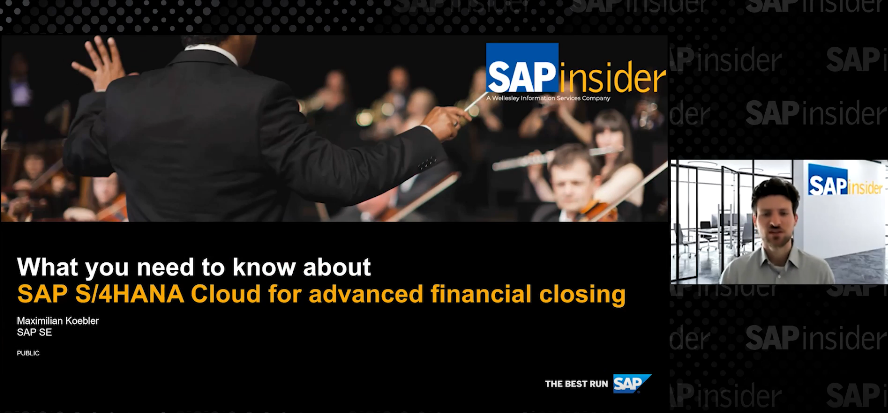Managing the Journal Entry and Approval Process in Your SAP Systems: Live Q&A with Brian Shannon
To quickly and efficiently complete the financial close process, accounting teams require solutions that enable them to create and approve multiple journal entries in a very tight time frame. Standardizing and streamlining journal entry processes is essential, as every delay in journal entry processing delays the company’s ability to report its financial results.
Dolphin’s Brian Shannon and Vishal Awasthi recently shared tips and best practices for creating automated, intelligent workflows to streamline the approval of complex journal entries, and improve controls. They answered questions on how to shorten the financial close such as:
- How can I lower the cost of journal entry processing?
- If I manage my journal entries in a spreadsheet, how can I easily create them in SAP systems?
- How can I simplify the journal entry approval process for the individuals involved?
- I have many journal entries that need to be reviewed and approved. What is the best way to do this within SAP without having to print them all?
- Does journal consolidation with universal journal help to drive better compliance? And if so, how?
Meet the panelists:
 Brian Shannon, Dolphin
Brian Shannon, Dolphin
As Dolphin’s Chief Strategy Officer, Mr. Shannon is focused on business processes and financial solutions to maximize return on investment. He has more than 20 years of SAP experience and his background includes thought leadership, knowledge management, project management, training and SAP consulting with extensive experience in the automotive and manufacturing sectors as well as oil and gas, retail and utility verticals.
 Vishal Awasthi, Dolphin
Vishal Awasthi, Dolphin
Vishal Awasthi is the Chief Technology Officer at Dolphin. He brings more than 15 years of solution architecture, product management and professional services background to Dolphin, and oversees the development of Dolphin products. Mr. Awasthi specializes in designing, implementing and supporting SAP centric enterprise business and information management solutions and has brought many of these products to market. Having worked on projects across North America, Europe and Asia Pacific, he has extensive experience in international assignments.
SAPinsiderMatt: Welcome to today’s Q&A on managing the journal entry and approval process in your SAP systems. I am pleased to be joined by Brian Shannon, Chief Strategy Officer at Dolphin, and Vishal Awasthi, Chief Technology Officer at Dolphin.
Before we begin with questions from readers, can we chat first about the importance of the journal entry process? What do you see as the greatest challenge facing finance teams who manage this process?
Brian Shannon: Well the problem is that unlike other business processes in SAP which are already digitized, journal entries are often still routed for approval using email and spreadsheets. This causes two major challenges for the finance department:
1. Manual processing causes delays
- Untimely approvals
- Rejections due to lack of supporting documentation
- Reversals and other corrections
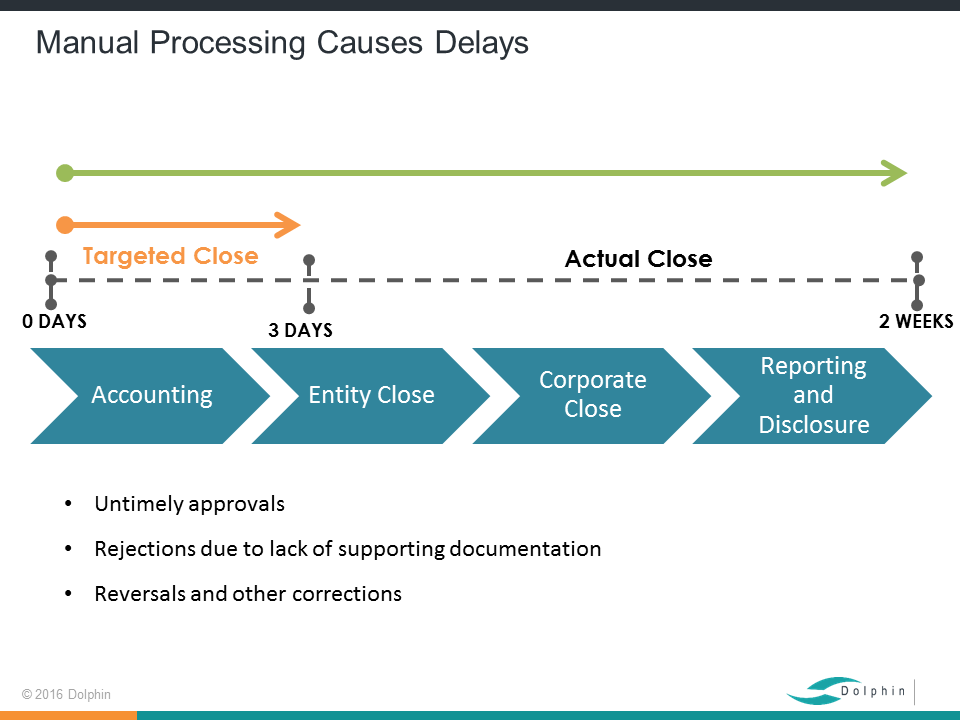
2. Manual processes lack transparency
- Financial close processes lack transparency and control due to user activities that happen outside of SAP:
- Email and other communications about journal entries
- Spreadsheets of journal entries are not included in workflow and not required to be attached
- Manual approvals and signatures
The Dolphin Journal Entry solution digitizes the journal entry process with an SAP-certified and SAP-centric solution that enables more efficient creation, approval, and posting of journal entries so organizations can achieve a faster, more secure financial close.
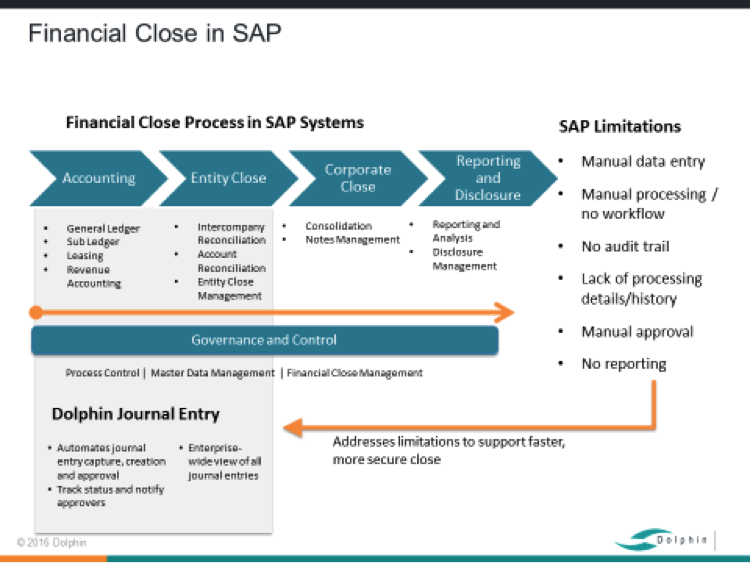
It provides a single view of journal entries across the enterprise. Key capabilities include:
- Real-time view of journal entries with PTS InfoCenter
- Upload journal entries from a Microsoft Excel spreadsheet
- Post journal entries that have more than 999 line items
- Configurable SAP workflows to route journal entries for approval
- Send notifications ensure timely approvals
- Enterprise-wide control over global and intercompany journal entries
- Support for multiple journal entry types: Standard journal entry, simple journal entry, foreign currency postings, accruals, recurring entry creation and changes, reversals, and cross-company reversals
Comment From Guest:
• If I manage my journal entries in a spreadsheet, how can I easily create them in SAP systems?
Brian Shannon: Yes, spreadsheet templates can provide a wealth of intelligence that can determine routing or auto-posting upon their submission into Dolphin Journal Entry. The spreadsheet can provide all necessary accounting details as well as currency, posting dates/periods, and document type. It even addresses the “999” line limitation of SAP. Validating the spreadsheet details before journal entries are created increases cycle time, and prevents problems later in the cycle. And if you already have templates set up, we can use those too!
Comment From Tommy: What’s the best way to route journal entries for approval?
Vishal Awasthi: Approval hierarchies are typically specified for expense management and invoice approval. For accounting entries, approval may be required for transactions that create intercompany postings, for transactions impacting certain general ledger (GL) accounts or cost centers, or for more sensitive types of adjusting transactions that can have a material impact.
In these cases, hierarchies may be different for transactions that impact the balance sheet versus the income statement. Dolphin Journal Entry permits variability in workflows depending on specified business rules and criteria. It has an easy-to-use approver registration table that then is used to build approval chains, send reminders, and, if necessary, escalations using SAP’s business workflow engine. Urgent or high priority/express transactions can also be managed with compressed time frames for approval/escalation. Finally, any custom approver chain build or the initial approver defaulting logic can be implemented through the user-exits.
Comment From Liz: How can I simplify the processing of large journal entries (more than 999 lines)?
Brian Shannon: SAP FI t-codes for journal entry do not allow posting documents with more than 999 lines, but with the Dolphin solution when the line count is more than 999, the lines will be parsed into separate FI documents for posting. The configuration tables will allow for a single GL account to be designated as a “balancing” account to facilitate the process.
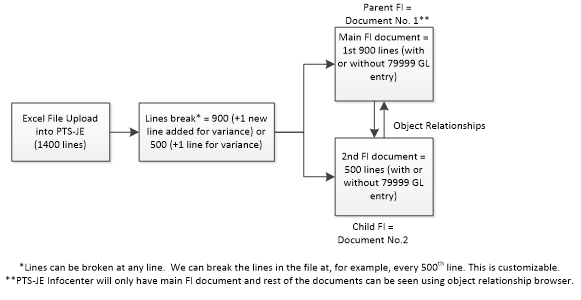
Dolphin has customers with documents with more than 50,000 lines, and the ability to automatically validate, approve, and post these journal entries saves the team a tremendous amount of time.
Comment From Jason: Does SAP workflow need to be turned on to use the Dolphin Journal Entry tool?
Vishal Awasthi: Dolphin does leverage the SAP workflow “engine,” but you do not need to activate any standard SAP workflow templates as our product comes with out-of-the-box, productized templates. All we need is an active workflow runtime in SWU3.
Comment From Guest: Are there different Microsoft Excel templates for different types of journal entries, for example, GL postings, customer postings, vendor postings, and so on?
Brian Shannon: The templates support GL entries as well as accrual entries, recurring entries, and the easy GL (FB50) posting types. And we can manage reversals as well.
Comment From Noorul: Will the approval mechanism in this solution only work if I have HCM or at least HR data in the system (PA30)?
Vishal Awasthi: No, Dolphin comes with our own approver and hierarchy as well as routing rules tables. If you happen to be using HCM/HR, we can tap into those as well, but that’s not a requirement.
Comment From M: How does the system handle the exchange of supporting documents?
Brian Shannon: Throughout the workflow process, all documents are visible and additional documents can be added. Security features exist to limit access to sensitive documents.
Comment From Susana: How can we determine which are true manual journal entries as opposed to those triggered by a process or hitting sub-ledgers and so on?
Brian Shannon: Manual processes are initiating a journal entry via a specific user and transaction code, whereas integrated accounting entries from upstream processes bear those t-code and user/system IDs.
Comment From Guest: How do you automate and centralize storing of supporting documentation? Is it linked to the actual journal entry document in the SAP system?
Vishal Awasthi: Dolphin can centrally and securely store the attachments in any ArchiveLink-certified repository. If you don’t have one implemented already, Dolphin offers a lean ArchiveLink connector for both on-premise or the leading cloud storage providers. And yes, the attachments are also linked to the final SAP FI journal entry documents.
Comment From Noorul: Can we restrict the F4 Help to only show a couple of GL accounts on the basis of a document type in the header? The Idea is that in Fortune 500 companies, some departments only work with a handful of document types and are only allowed to use some GL accounts. There has been a requirement of restricting the F4 Help to show only a couple of GL accounts and not the entire chart.
Brian Shannon: An additional check can be made to the SAP security object or business rule to limit access to various elements of the posting.
Comment From Ed: is the Dolphin Journal Entry tool compatible with SAP S/4HANA Finance (formerly SAP Simple Finance)?
Vishal Awasthi: Yes it is.
Comment From Noorul: Is there a mechanism to identify/group multiple documents if they have been broken up due to the 999 limit? For example, do they use the same reference in the document header?
Brian Shannon: Yes, there is a linkage to the multiple documents.
Comment From Guest: So are you saying that you handle only GL postings (like FB50) but not postings FB60 and FB70?
Brian Shannon: Generally FB60 or FB70 are addressed in our accounts payable (AP) and accounts receivable (AR) solutions. The Dolphin Journal Entry solution does permit access to complex postings via FB01 which you can certainly add vendor, customer, or asset sub-ledger account lines.
Comment From Guest: Can the templates be used to set up non-PO recurring vendor invoices?
Brian Shannon: Yes, transactions that are recurring can be set up in the tool. Reversals as well! However, the Dolphin Accounts Payable solution offers much greater levels of functionality for AP transactions.
Comment From lmorri2: Can you give some examples of automated validation and approvals?
Brian Shannon: In addition to standard SAP FI document validity checks, the Dolphin solution also does early “pre-emptive” validations for common mistakes such as invalid GL or cost center. Users receive an error message indicating the row and error. Users can then go back to the spreadsheet right away, correct the error, and re-upload it.
Comment From Guest: Do users have to choose between templates when creating a spreadsheet for an entry? Can multiple entries be contained on a single spreadsheet?
Vishal Awasthi: Template identification in Dolphin is done through a unique signature mapping where the tool can look for a unique pattern anywhere in the Microsoft Excel spreadsheet. Generally, it’s better to keep one spreadsheet to one journal entry, but in certain high-volume use cases, it is possible to lump multiple journal entries into one spreadsheet and have the Dolphin parser break it upon the file import, or during posting after the approvals.
Comment From Guest: How do you handle workflow items for a journal entry document that was reversed due to an error after it was already routed for approval and the work item is sitting in the approvers workflow inbox?
Vishal Awasthi: The requester or an Admin has the option to recall an item from the approver’s queue.
Comment From Allison: How can I achieve a single view of journal entries across the enterprise?
Brian Shannon: There must be availability of source documents and an understanding of where others can obtain the details of the journal entry. For instance, if you are using an external share drive, or if you use email to communicate the composition of the journal before it is posted, or if you still print supporting documents as a means of sharing the detail, it is easy to see the limitations.
The share drive challenge is knowing where/how to find the documents and communicating when they are saved there. With email, it is opaque and does not share the details across the enterprise. Printing documents is obviously limited to those people who can share a piece of paper with you.
To provide a true, single view of journal entries across the enterprise throughout their life cycle (i.e., before and after they are posted), requires a tool within SAP to identify the existence and location of the documents.
Dolphin Journal Entry provides a dashboard with transaction-specific status codes that immediately provide details about the journal entry — such as, if they are awaiting review or approval — and the supporting documents that were used to create the transactions. So in essence, it is a single view across the enterprise.
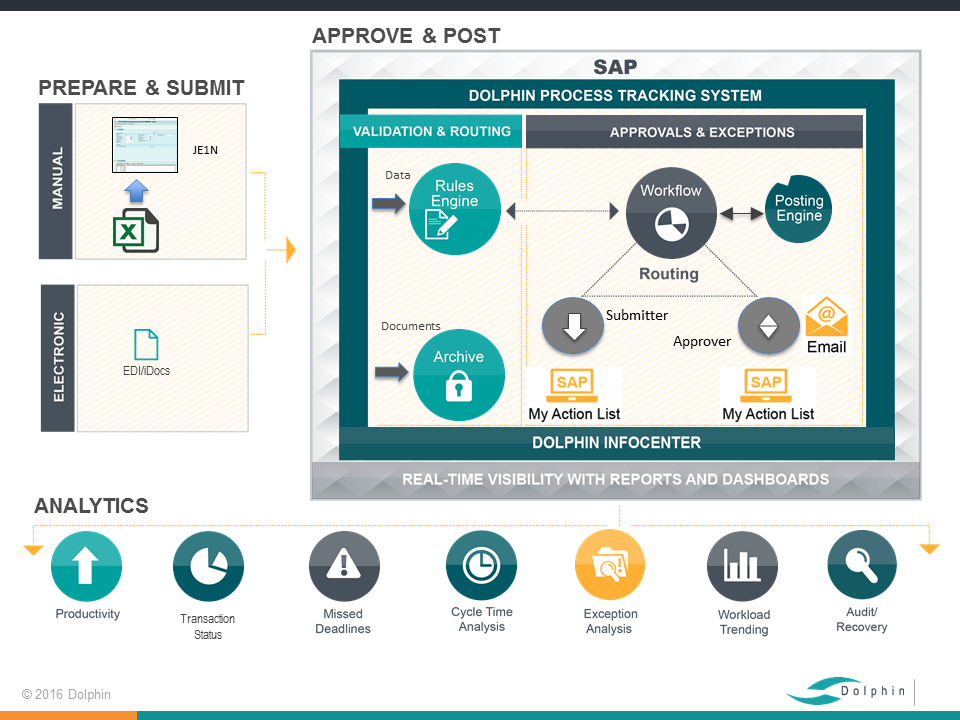
Comment From Noorul: In the case of some errors, does it give a parking slot where the errors can be resolved or would it just error out, giving the errors and data that needs to be corrected in the spreadsheet and uploaded again?
Vishal Awasthi: You have both options. You can configure the tool in a way where a user is not allowed to alter data directly in the Dolphin tool and any errors would have to be fixed in the spreadhseet itself, or you can open up the Dolphin screen for updates. It can also be configured for a mixed-mode where this distinction can be made on the basis of the type of the exception.
Comment From Guest: How does the journal entry approval table work as compared to the Dolphin AP approval table?
Brian Shannon: The tables are shared presently to minimize maintenance, but can be managed separately if other conditions necessitate.
Comment From Guest: Can your solution be used on mobile devices?
Vishal Awasthi: Yes, it can be used through our SAP Fiori app, and if activated, the approvers can also approve directly from the email itself.
Comment From Guest: Is it one approval per the upload batch, or does each line item need to be approved individually?
Brian Shannon: It is one approval per spreadsheet upload, but it might result in an approval chain build ( multiple approvers for one journal entries).
Comment From Jhan: How can I lower the cost of journal entry processing?
Brian Shannon: Lowering the cost of journal entry processing is about shrinking the cycle time, providing access to all levels of detail in one place. Users need only to go into SAP to see transactions in process, who currently is working on the entry, and without requiring expensive additional effort to store, index, and retrieve supporting documents from an external file storage. Additionally, it reduces the risk of transactions being incorrectly posted or of not having the requisite back up documentation in times of audit. Less overhead expense and mitigated risk means overall lower cost of journal entry processing.
Comment From Noorul: We have always used “park and post functionality” for the workflow generation, but this has issues — WRT number ranges, for example. At times, a document does not get approved for months, and as such when taking out a report for the month, some old document numbers start appearing which causes confusion for the auditors. Can we use the hold functionality for workflow?
Vishal Awasthi: This is a classic challenge with the parking in SAP. This is why in Dolphin we do not create a parked FI document. We hold the in-workflow data and documents within the Dolphin container and only post a clean FI journal entry at the end of the process.
Comment From Jeanne: If I manage my journal entries in a spreadsheet, how can I easily create them in SAP systems?
Brian Shannon: There is always the capability to simply upload spreadsheet details into an SAP transaction. However, the Dolphin solution permits the transaction to be uploaded with specific business rules, controlled storage, and visibility from a dashboard to anyone who needs to see the document while it is being processed or after it has posted.
Comment From Guest: Considering the front end is SAP Fiori, do we need to be on the SAP HANA database to use the tool?
Vishal Awasthi: Actually, the front end is SAP GUI as well as the web. The web interface does not require SAP Fiori or SAP HANA. If you have those components, we will leverage them, but the Dolphin’s UI5 interface can also run outside of SAP Fiori.
Comment From Molly: How can I simplify the journal entry approval process for the individuals involved?
Brian Shannon: You can simplify the approval process by giving them a tool that is easy to use and provides all of the necessary information in a consistent manner each time. This means eliminate the emails that require someone to type (and therefore have to read) too much text, which may or may not require further explanation. The use of configurable reason codes when sending an item for approval, together with all the necessary back-up and additional notes gives the approver everything they need to approve the transaction. UI5 or simple email approvals are available.
Comment From Guest: Can your solution provide approvals for journal entry documents that are already posted?
Vishal Awasthi: We do allow you to process a journal entry as a draft and — instead of creating a new FI document after the posting — link an already posted FI document to it.
Comment From Noorul: Does this mean that until the documents are posted, they only remain in the Dolphin container and no SAP tables are updated at all? If so, is there a reporting tool that helps identify all the documents not yet posted or any other reporting capability in the tool?
Brian Shannon: The Dolphin solution is within SAP. It’s a certified solution with its own transaction codes and table namespace. The solution leverages the SAP system’s internal date/time/user stamp, and as the journal entry moves through its natural life cycle, Dolphin’s status and sub-status codes are used to identify where the transaction is in the process. Robust reports and metrics provide detailed reporting for continuous improvement initiatives.
Comment From Noorul: Does the tool take care of ledger-specific entries or entries with only single currencies? This would be very handy during the month ends.
Brian Shannon: The solution supports standard SAP FX currencies (FB01). At the SAP document level, you cannot post more than one currency on a document.
Comment From Bob – GC America: I have many journal entries that need to be reviewed and approved. What is the best way to do this within SAP without having to print them all?
Brian Shannon: Digitize the process. But digitization is more than just forwarding by email; digitization improves transparency for everyone in the organization. Users can easily view entries in SAP, on the web, on a mobile device or in an email. Look for a solution that makes it easy for the user to see the items that need approval quickly. Workflows can be configured to send additional notifications if an item is not approved in a timely manner or to forward the item to another user for processing.
Comment From Ed: Can you please provide details on any replication procedures involved here?
Vishal Awasthi: If I am understanding you correctly, you would like to take an earlier journal entry, replicate it with some updates, and then submit it as new? If so, then yes. We call this a “respawn” feature. We are also working on a recurring journal entry feature where you can set up a template and have a Dolphin report auto-submit it for approvals at predefined frequency.
Comment From Guest: Does journal consolidation with universal journal help to drive better compliance? And if so, how?
Brian Shannon: Journal consolidation with universal journal does simplify the reconciliation process (there is no longer a reconciliation between FI & CO). The Dolphin solution provides automation (which you can make mandatory) of transactions with supporting documentation and approval hierarchies attached to the SAP document itself for improved auditability and control.
Comment From Guest: Is there a process to set up approval workflows for a payment proposal?
Brian Shannon: No, the Dolphin Journal Entry solution does not provide this capability.
Comment From Emily K: Can I make it mandatory for users to attach the necessary supporting documentation?
Brian Shannon: Yes, not only is providing supporting documentation a best practice in finance, but for many companies in regulated industries it is required. The Dolphin solution can be configured to require supporting documentation depending on the type of journal entry.
Comment From Allison: What can I do to improve Sarbanes-Oxley (SOX) compliance?
Vishal Awasthi: Many Dolphin customers have used the Dolphin tool to improve SOX compliance where they removed the requester and approver’s access to the SAP posting t-codes and only allowed the automated FI posting through the Dolphin workflow. This ensures better adherence to the controls and the auditors love it.
Comment From Ed: Can you use DE journal entry for companies that haven’t activated new GL?
Brian Shannon: The solution does not require the new GL.
Comment From Rachel: How can I ensure that an audit trail is maintained for journal entry corrections or reclassifications?
Brian Shannon: While SAP records the reversal, it doesn’t record the process that led to the reversal. Dolphin Journal Entry automates the reversal process as well as the creation process, so there is a complete trail for any reversals made including supporting documentation, approvals, and notes.
Comment From lmorri2@bloomberg.net: Do you have the ability for a back-up approver, for example, when someone is on vacation?
Vishal Awasthi: Yes, the tool offers standard capability for out-of-office substitute maintenance. While the substitution is active, both the original approver and the substitute can take action on the record sent to the original approver. Also both get copied on the notification emails.
SAPinsiderMatt: Thank you to everyone who participated in today’s Q&A. We had a lot of great questions! The panelists are answering the last few questions now.
Comment From Nik: What are your recommendations for simplifying the journal entry approval process?
Brian Shannon: Digitize the process as much as possible to improve speed, accuracy, and transparency. Validate journal entries automatically. Any validation that can be done before a journal entry is created in SAP will save you time and effort down the road. Use workflow to automatically route journal entries for approval. Workflows can dramatically improve approval cycle time and make it easier for users to prioritize items during the critical financial close period. Dolphin’s Journal Entry solution uses SAP workflows to route journal entries for approval. Improve transparency by looking for solutions that provide real-time information on journal entries being processed.
Comment From Yi: What analysis tools are available to help me identify areas for improvement in my financial close?
Vishal Awasthi: This is where the key performance indicator (KPI) reports come in to play. You can get deep insight into the magnitude and reason for delays in the critical journal entry postings that collectively delay the financial close. This way you can pinpoint the common reasons for the delays, whether it is the quality of data or a delay caused by inaction on part of the approvers.
SAPinsiderMatt: Thank you Brian and Vishal for your time and insightful answers! You can review the Q&A chat replay at any time, and I will alert you by email when the transcript of today’s discussion is posted.
To quickly and efficiently complete the financial close process, accounting teams require solutions that enable them to create and approve multiple journal entries in a very tight time frame. Standardizing and streamlining journal entry processes is essential, as every delay in journal entry processing delays the company’s ability to report its financial results.
Dolphin’s Brian Shannon and Vishal Awasthi recently shared tips and best practices for creating automated, intelligent workflows to streamline the approval of complex journal entries, and improve controls. They answered questions on how to shorten the financial close such as:
- How can I lower the cost of journal entry processing?
- If I manage my journal entries in a spreadsheet, how can I easily create them in SAP systems?
- How can I simplify the journal entry approval process for the individuals involved?
- I have many journal entries that need to be reviewed and approved. What is the best way to do this within SAP without having to print them all?
- Does journal consolidation with universal journal help to drive better compliance? And if so, how?
Meet the panelists:
 Brian Shannon, Dolphin
Brian Shannon, Dolphin
As Dolphin’s Chief Strategy Officer, Mr. Shannon is focused on business processes and financial solutions to maximize return on investment. He has more than 20 years of SAP experience and his background includes thought leadership, knowledge management, project management, training and SAP consulting with extensive experience in the automotive and manufacturing sectors as well as oil and gas, retail and utility verticals.
 Vishal Awasthi, Dolphin
Vishal Awasthi, Dolphin
Vishal Awasthi is the Chief Technology Officer at Dolphin. He brings more than 15 years of solution architecture, product management and professional services background to Dolphin, and oversees the development of Dolphin products. Mr. Awasthi specializes in designing, implementing and supporting SAP centric enterprise business and information management solutions and has brought many of these products to market. Having worked on projects across North America, Europe and Asia Pacific, he has extensive experience in international assignments.
SAPinsiderMatt: Welcome to today’s Q&A on managing the journal entry and approval process in your SAP systems. I am pleased to be joined by Brian Shannon, Chief Strategy Officer at Dolphin, and Vishal Awasthi, Chief Technology Officer at Dolphin.
Before we begin with questions from readers, can we chat first about the importance of the journal entry process? What do you see as the greatest challenge facing finance teams who manage this process?
Brian Shannon: Well the problem is that unlike other business processes in SAP which are already digitized, journal entries are often still routed for approval using email and spreadsheets. This causes two major challenges for the finance department:
1. Manual processing causes delays
- Untimely approvals
- Rejections due to lack of supporting documentation
- Reversals and other corrections

2. Manual processes lack transparency
- Financial close processes lack transparency and control due to user activities that happen outside of SAP:
- Email and other communications about journal entries
- Spreadsheets of journal entries are not included in workflow and not required to be attached
- Manual approvals and signatures
The Dolphin Journal Entry solution digitizes the journal entry process with an SAP-certified and SAP-centric solution that enables more efficient creation, approval, and posting of journal entries so organizations can achieve a faster, more secure financial close.

It provides a single view of journal entries across the enterprise. Key capabilities include:
- Real-time view of journal entries with PTS InfoCenter
- Upload journal entries from a Microsoft Excel spreadsheet
- Post journal entries that have more than 999 line items
- Configurable SAP workflows to route journal entries for approval
- Send notifications ensure timely approvals
- Enterprise-wide control over global and intercompany journal entries
- Support for multiple journal entry types: Standard journal entry, simple journal entry, foreign currency postings, accruals, recurring entry creation and changes, reversals, and cross-company reversals
Comment From Guest:
• If I manage my journal entries in a spreadsheet, how can I easily create them in SAP systems?
Brian Shannon: Yes, spreadsheet templates can provide a wealth of intelligence that can determine routing or auto-posting upon their submission into Dolphin Journal Entry. The spreadsheet can provide all necessary accounting details as well as currency, posting dates/periods, and document type. It even addresses the “999” line limitation of SAP. Validating the spreadsheet details before journal entries are created increases cycle time, and prevents problems later in the cycle. And if you already have templates set up, we can use those too!
Comment From Tommy: What’s the best way to route journal entries for approval?
Vishal Awasthi: Approval hierarchies are typically specified for expense management and invoice approval. For accounting entries, approval may be required for transactions that create intercompany postings, for transactions impacting certain general ledger (GL) accounts or cost centers, or for more sensitive types of adjusting transactions that can have a material impact.
In these cases, hierarchies may be different for transactions that impact the balance sheet versus the income statement. Dolphin Journal Entry permits variability in workflows depending on specified business rules and criteria. It has an easy-to-use approver registration table that then is used to build approval chains, send reminders, and, if necessary, escalations using SAP’s business workflow engine. Urgent or high priority/express transactions can also be managed with compressed time frames for approval/escalation. Finally, any custom approver chain build or the initial approver defaulting logic can be implemented through the user-exits.
Comment From Liz: How can I simplify the processing of large journal entries (more than 999 lines)?
Brian Shannon: SAP FI t-codes for journal entry do not allow posting documents with more than 999 lines, but with the Dolphin solution when the line count is more than 999, the lines will be parsed into separate FI documents for posting. The configuration tables will allow for a single GL account to be designated as a “balancing” account to facilitate the process.

Dolphin has customers with documents with more than 50,000 lines, and the ability to automatically validate, approve, and post these journal entries saves the team a tremendous amount of time.
Comment From Jason: Does SAP workflow need to be turned on to use the Dolphin Journal Entry tool?
Vishal Awasthi: Dolphin does leverage the SAP workflow “engine,” but you do not need to activate any standard SAP workflow templates as our product comes with out-of-the-box, productized templates. All we need is an active workflow runtime in SWU3.
Comment From Guest: Are there different Microsoft Excel templates for different types of journal entries, for example, GL postings, customer postings, vendor postings, and so on?
Brian Shannon: The templates support GL entries as well as accrual entries, recurring entries, and the easy GL (FB50) posting types. And we can manage reversals as well.
Comment From Noorul: Will the approval mechanism in this solution only work if I have HCM or at least HR data in the system (PA30)?
Vishal Awasthi: No, Dolphin comes with our own approver and hierarchy as well as routing rules tables. If you happen to be using HCM/HR, we can tap into those as well, but that’s not a requirement.
Comment From M: How does the system handle the exchange of supporting documents?
Brian Shannon: Throughout the workflow process, all documents are visible and additional documents can be added. Security features exist to limit access to sensitive documents.
Comment From Susana: How can we determine which are true manual journal entries as opposed to those triggered by a process or hitting sub-ledgers and so on?
Brian Shannon: Manual processes are initiating a journal entry via a specific user and transaction code, whereas integrated accounting entries from upstream processes bear those t-code and user/system IDs.
Comment From Guest: How do you automate and centralize storing of supporting documentation? Is it linked to the actual journal entry document in the SAP system?
Vishal Awasthi: Dolphin can centrally and securely store the attachments in any ArchiveLink-certified repository. If you don’t have one implemented already, Dolphin offers a lean ArchiveLink connector for both on-premise or the leading cloud storage providers. And yes, the attachments are also linked to the final SAP FI journal entry documents.
Comment From Noorul: Can we restrict the F4 Help to only show a couple of GL accounts on the basis of a document type in the header? The Idea is that in Fortune 500 companies, some departments only work with a handful of document types and are only allowed to use some GL accounts. There has been a requirement of restricting the F4 Help to show only a couple of GL accounts and not the entire chart.
Brian Shannon: An additional check can be made to the SAP security object or business rule to limit access to various elements of the posting.
Comment From Ed: is the Dolphin Journal Entry tool compatible with SAP S/4HANA Finance (formerly SAP Simple Finance)?
Vishal Awasthi: Yes it is.
Comment From Noorul: Is there a mechanism to identify/group multiple documents if they have been broken up due to the 999 limit? For example, do they use the same reference in the document header?
Brian Shannon: Yes, there is a linkage to the multiple documents.
Comment From Guest: So are you saying that you handle only GL postings (like FB50) but not postings FB60 and FB70?
Brian Shannon: Generally FB60 or FB70 are addressed in our accounts payable (AP) and accounts receivable (AR) solutions. The Dolphin Journal Entry solution does permit access to complex postings via FB01 which you can certainly add vendor, customer, or asset sub-ledger account lines.
Comment From Guest: Can the templates be used to set up non-PO recurring vendor invoices?
Brian Shannon: Yes, transactions that are recurring can be set up in the tool. Reversals as well! However, the Dolphin Accounts Payable solution offers much greater levels of functionality for AP transactions.
Comment From lmorri2: Can you give some examples of automated validation and approvals?
Brian Shannon: In addition to standard SAP FI document validity checks, the Dolphin solution also does early “pre-emptive” validations for common mistakes such as invalid GL or cost center. Users receive an error message indicating the row and error. Users can then go back to the spreadsheet right away, correct the error, and re-upload it.
Comment From Guest: Do users have to choose between templates when creating a spreadsheet for an entry? Can multiple entries be contained on a single spreadsheet?
Vishal Awasthi: Template identification in Dolphin is done through a unique signature mapping where the tool can look for a unique pattern anywhere in the Microsoft Excel spreadsheet. Generally, it’s better to keep one spreadsheet to one journal entry, but in certain high-volume use cases, it is possible to lump multiple journal entries into one spreadsheet and have the Dolphin parser break it upon the file import, or during posting after the approvals.
Comment From Guest: How do you handle workflow items for a journal entry document that was reversed due to an error after it was already routed for approval and the work item is sitting in the approvers workflow inbox?
Vishal Awasthi: The requester or an Admin has the option to recall an item from the approver’s queue.
Comment From Allison: How can I achieve a single view of journal entries across the enterprise?
Brian Shannon: There must be availability of source documents and an understanding of where others can obtain the details of the journal entry. For instance, if you are using an external share drive, or if you use email to communicate the composition of the journal before it is posted, or if you still print supporting documents as a means of sharing the detail, it is easy to see the limitations.
The share drive challenge is knowing where/how to find the documents and communicating when they are saved there. With email, it is opaque and does not share the details across the enterprise. Printing documents is obviously limited to those people who can share a piece of paper with you.
To provide a true, single view of journal entries across the enterprise throughout their life cycle (i.e., before and after they are posted), requires a tool within SAP to identify the existence and location of the documents.
Dolphin Journal Entry provides a dashboard with transaction-specific status codes that immediately provide details about the journal entry — such as, if they are awaiting review or approval — and the supporting documents that were used to create the transactions. So in essence, it is a single view across the enterprise.

Comment From Noorul: In the case of some errors, does it give a parking slot where the errors can be resolved or would it just error out, giving the errors and data that needs to be corrected in the spreadsheet and uploaded again?
Vishal Awasthi: You have both options. You can configure the tool in a way where a user is not allowed to alter data directly in the Dolphin tool and any errors would have to be fixed in the spreadhseet itself, or you can open up the Dolphin screen for updates. It can also be configured for a mixed-mode where this distinction can be made on the basis of the type of the exception.
Comment From Guest: How does the journal entry approval table work as compared to the Dolphin AP approval table?
Brian Shannon: The tables are shared presently to minimize maintenance, but can be managed separately if other conditions necessitate.
Comment From Guest: Can your solution be used on mobile devices?
Vishal Awasthi: Yes, it can be used through our SAP Fiori app, and if activated, the approvers can also approve directly from the email itself.
Comment From Guest: Is it one approval per the upload batch, or does each line item need to be approved individually?
Brian Shannon: It is one approval per spreadsheet upload, but it might result in an approval chain build ( multiple approvers for one journal entries).
Comment From Jhan: How can I lower the cost of journal entry processing?
Brian Shannon: Lowering the cost of journal entry processing is about shrinking the cycle time, providing access to all levels of detail in one place. Users need only to go into SAP to see transactions in process, who currently is working on the entry, and without requiring expensive additional effort to store, index, and retrieve supporting documents from an external file storage. Additionally, it reduces the risk of transactions being incorrectly posted or of not having the requisite back up documentation in times of audit. Less overhead expense and mitigated risk means overall lower cost of journal entry processing.
Comment From Noorul: We have always used “park and post functionality” for the workflow generation, but this has issues — WRT number ranges, for example. At times, a document does not get approved for months, and as such when taking out a report for the month, some old document numbers start appearing which causes confusion for the auditors. Can we use the hold functionality for workflow?
Vishal Awasthi: This is a classic challenge with the parking in SAP. This is why in Dolphin we do not create a parked FI document. We hold the in-workflow data and documents within the Dolphin container and only post a clean FI journal entry at the end of the process.
Comment From Jeanne: If I manage my journal entries in a spreadsheet, how can I easily create them in SAP systems?
Brian Shannon: There is always the capability to simply upload spreadsheet details into an SAP transaction. However, the Dolphin solution permits the transaction to be uploaded with specific business rules, controlled storage, and visibility from a dashboard to anyone who needs to see the document while it is being processed or after it has posted.
Comment From Guest: Considering the front end is SAP Fiori, do we need to be on the SAP HANA database to use the tool?
Vishal Awasthi: Actually, the front end is SAP GUI as well as the web. The web interface does not require SAP Fiori or SAP HANA. If you have those components, we will leverage them, but the Dolphin’s UI5 interface can also run outside of SAP Fiori.
Comment From Molly: How can I simplify the journal entry approval process for the individuals involved?
Brian Shannon: You can simplify the approval process by giving them a tool that is easy to use and provides all of the necessary information in a consistent manner each time. This means eliminate the emails that require someone to type (and therefore have to read) too much text, which may or may not require further explanation. The use of configurable reason codes when sending an item for approval, together with all the necessary back-up and additional notes gives the approver everything they need to approve the transaction. UI5 or simple email approvals are available.
Comment From Guest: Can your solution provide approvals for journal entry documents that are already posted?
Vishal Awasthi: We do allow you to process a journal entry as a draft and — instead of creating a new FI document after the posting — link an already posted FI document to it.
Comment From Noorul: Does this mean that until the documents are posted, they only remain in the Dolphin container and no SAP tables are updated at all? If so, is there a reporting tool that helps identify all the documents not yet posted or any other reporting capability in the tool?
Brian Shannon: The Dolphin solution is within SAP. It’s a certified solution with its own transaction codes and table namespace. The solution leverages the SAP system’s internal date/time/user stamp, and as the journal entry moves through its natural life cycle, Dolphin’s status and sub-status codes are used to identify where the transaction is in the process. Robust reports and metrics provide detailed reporting for continuous improvement initiatives.
Comment From Noorul: Does the tool take care of ledger-specific entries or entries with only single currencies? This would be very handy during the month ends.
Brian Shannon: The solution supports standard SAP FX currencies (FB01). At the SAP document level, you cannot post more than one currency on a document.
Comment From Bob – GC America: I have many journal entries that need to be reviewed and approved. What is the best way to do this within SAP without having to print them all?
Brian Shannon: Digitize the process. But digitization is more than just forwarding by email; digitization improves transparency for everyone in the organization. Users can easily view entries in SAP, on the web, on a mobile device or in an email. Look for a solution that makes it easy for the user to see the items that need approval quickly. Workflows can be configured to send additional notifications if an item is not approved in a timely manner or to forward the item to another user for processing.
Comment From Ed: Can you please provide details on any replication procedures involved here?
Vishal Awasthi: If I am understanding you correctly, you would like to take an earlier journal entry, replicate it with some updates, and then submit it as new? If so, then yes. We call this a “respawn” feature. We are also working on a recurring journal entry feature where you can set up a template and have a Dolphin report auto-submit it for approvals at predefined frequency.
Comment From Guest: Does journal consolidation with universal journal help to drive better compliance? And if so, how?
Brian Shannon: Journal consolidation with universal journal does simplify the reconciliation process (there is no longer a reconciliation between FI & CO). The Dolphin solution provides automation (which you can make mandatory) of transactions with supporting documentation and approval hierarchies attached to the SAP document itself for improved auditability and control.
Comment From Guest: Is there a process to set up approval workflows for a payment proposal?
Brian Shannon: No, the Dolphin Journal Entry solution does not provide this capability.
Comment From Emily K: Can I make it mandatory for users to attach the necessary supporting documentation?
Brian Shannon: Yes, not only is providing supporting documentation a best practice in finance, but for many companies in regulated industries it is required. The Dolphin solution can be configured to require supporting documentation depending on the type of journal entry.
Comment From Allison: What can I do to improve Sarbanes-Oxley (SOX) compliance?
Vishal Awasthi: Many Dolphin customers have used the Dolphin tool to improve SOX compliance where they removed the requester and approver’s access to the SAP posting t-codes and only allowed the automated FI posting through the Dolphin workflow. This ensures better adherence to the controls and the auditors love it.
Comment From Ed: Can you use DE journal entry for companies that haven’t activated new GL?
Brian Shannon: The solution does not require the new GL.
Comment From Rachel: How can I ensure that an audit trail is maintained for journal entry corrections or reclassifications?
Brian Shannon: While SAP records the reversal, it doesn’t record the process that led to the reversal. Dolphin Journal Entry automates the reversal process as well as the creation process, so there is a complete trail for any reversals made including supporting documentation, approvals, and notes.
Comment From lmorri2@bloomberg.net: Do you have the ability for a back-up approver, for example, when someone is on vacation?
Vishal Awasthi: Yes, the tool offers standard capability for out-of-office substitute maintenance. While the substitution is active, both the original approver and the substitute can take action on the record sent to the original approver. Also both get copied on the notification emails.
SAPinsiderMatt: Thank you to everyone who participated in today’s Q&A. We had a lot of great questions! The panelists are answering the last few questions now.
Comment From Nik: What are your recommendations for simplifying the journal entry approval process?
Brian Shannon: Digitize the process as much as possible to improve speed, accuracy, and transparency. Validate journal entries automatically. Any validation that can be done before a journal entry is created in SAP will save you time and effort down the road. Use workflow to automatically route journal entries for approval. Workflows can dramatically improve approval cycle time and make it easier for users to prioritize items during the critical financial close period. Dolphin’s Journal Entry solution uses SAP workflows to route journal entries for approval. Improve transparency by looking for solutions that provide real-time information on journal entries being processed.
Comment From Yi: What analysis tools are available to help me identify areas for improvement in my financial close?
Vishal Awasthi: This is where the key performance indicator (KPI) reports come in to play. You can get deep insight into the magnitude and reason for delays in the critical journal entry postings that collectively delay the financial close. This way you can pinpoint the common reasons for the delays, whether it is the quality of data or a delay caused by inaction on part of the approvers.
SAPinsiderMatt: Thank you Brian and Vishal for your time and insightful answers! You can review the Q&A chat replay at any time, and I will alert you by email when the transcript of today’s discussion is posted.




